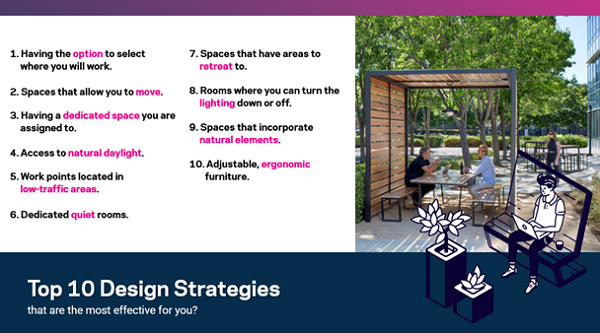To understand how companies can better serve neurodiverse employees, HOK, a global design, architecture, engineering, and planning firm, partnered with Tarkett, a workplace design company, to
survey 202 neurodiverse individuals, focusing on women and workers older than 30. The survey found that these individuals suffer from sensory challenges, and employers should consider this when designing a more supportive and inclusive workplace.
No Jitter interviewed
Kay Sargent, director of Workplace, HOK, to discuss what defines a neurodiverse individual, how neurodiverse talent can strengthen a workforce, and how companies can enact change regarding diversity, equity, and inclusion (DEI) initiatives. Sargent also shared what companies must include in their checklist for success around neurodiversity inclusion, how to create a
company culture that gives a sense of belonging, and advice for companies that want to expand their DEI initiatives to include neurodiversity. Sargent also touched on three challenges currently impeding work environments for neurodiverse employees.
Responses have been edited for conciseness and clarity.
What defines neurodiversity?
KS: Neurodiversity refers to variations in human neurocognitive functioning—the different ways we think, process information, and relate to others. Neurominorities diverge from dominant societal norms for processing information and are wired differently. [Statistics estimate] that as many as one in seven people are part of this group, which includes individuals with ADHD, autism,
dyspraxia, and dyslexia. Hence, neurodiverse people make up one of the largest underrepresented groups in the workplace.
How can neurodiverse talent strengthen a workforce?
KS: Neurodiverse people can bring new perspectives to a company’s efforts to create or recognize value. Many people with a neurodiverse profile are high-performing, driven individuals who are bold problem solvers who excel in a crisis—the very traits in great demand at the moment. Recent studies have shown that when individuals are in supportive environments, they can be very effective and bring great abilities to organizations.
What top challenges currently impede work environments’ support for neurodiversity?
KS: [It’s important to provide] individuals with options, choice, and some degree of control. We know environments designed with a “one-size-fits-all” mindset tend to be demanding for those with specific needs or heightened sensory processing challenges. [Neurodiverse] individuals tend to have the biggest challenges around acoustics, lighting, and temperature levels in shared spaces. Those are tightly followed by being in densely populated spaces with close proximity to others.
According to Return On Disability Group, although 90% of companies claim to prioritize diversity, only 4% consider disability in those initiatives. How can companies enact change?
KS: As more and more companies are looking to address their environmental, social, and governance (ESG) goals and as the war for talent tightens, we see companies widen their reach. We believe we all have an obligation to press the issue and ensure DEI initiatives are addressed in the workplace. To do so, we must advocate for creating environments where all can feel welcome.
To start, companies must review their recruiting, hiring, and onboarding processes. They must also address the workplace to ensure it offers the right settings, options, and controls for individuals, coupled with some degree of personal adjustments and accommodations to address further specific needs that individuals may have.
What must companies include in their checklist for success around neurodiversity inclusion?
KS: Companies can do many things to create a more welcoming environment for neurominorities. Here is a list of the 10 things companies can do now to create more welcoming spaces:
How can companies create a culture that offers and encourages flexibility while giving neurodiverse employees a sense of belonging?
KS: Designing a space that allows for some degree of control is key. For some, that might be flexibility within the shared space to select a work point and setting that meet their needs. For others, it might be having the ability to work remotely or have different hours. But to ensure a sense of belonging, we must strive to create spaces that are inclusive and don’t force people to only work remotely.
What advice do you have for companies that want to expand their DEI initiatives to include neurodiversity?
KS: The World Health Organization recently redefined the term disability: “Physical, cognitive and social exclusion can occur at the point of interaction between the individual and an environment when there is a misalignment between them.” Hence, we need to create spaces that don’t create barriers for individuals.
What components in office design are required to help a facility be fluid and adaptable to neurodiverse employees?
KS: It’s important to create spaces that can meet the needs of neurodiverse employees and that we provide hyper[sensitive] and hypo[sensitive] versions of various work settings (see graphic below). That might include ensuring that there are quiet areas and activity spaces to meet various sensory processing needs of individuals. It’s also important to allow for lighting and temperature tolerances and to provide spaces that aren’t overly visually chaotic and have a sense of order.











